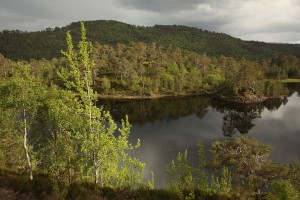
On the 8th of June I went out to Glen Affric for a gentle day of photography. I’d been suffering from sciatica in one of my legs recently, so I wasn’t very mobile, but the advice I’d received was that exercise is good for the condition. My plan therefore was to see if I could find some good subjects for photography along the roadside in the glen, so that I wouldn’t have to walk too far. I reasoned that this would avoid putting undue stress on my leg, while at the same time enabling me to fulfil my creative desires with the camera.
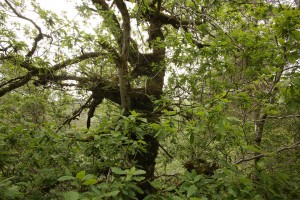
Arriving at the eastern end of the glen, I stopped beside one of the few remaining oak trees (Quercus petraea) there, which is growing right beside the road, above where the Affric River plunges down over Badger Falls. The tree is growing on the down-slope side of the road, just where a small burn flows through a culvert, and as a result some of the tree’s branches are level with the top of the parapet at the road edge. This means that it’s an ideal place to look at the tree’s leaves in close-up, and to search for any insects that are living there.
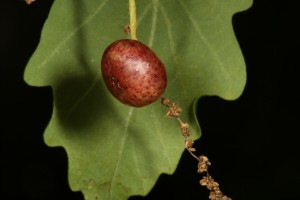
Almost immediately I spotted something of interest – a spherical shape on a catkin of the oak tree. It was a currant gall, which is induced to form on the oak’s catkins by the sexual generation of a tiny wasp (Neuroterus quercusbaccarum). Male and female wasps emerge from these galls in early summer, mate and lay their eggs on the undersides of the oak’s leaves, where they induce the development of spangle galls, which house the agamic, or asexual, generation of the wasps. The larvae inside each spangle gall continue developing after the leaves fall to the ground in the autumn, and adult female wasps emerge in spring, to lay their eggs (without mating) on the oak’s catkins, and so the cycle repeats each year.
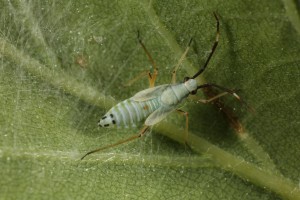
Turning over a leaf nearby I found a beautiful pale turquoise-coloured bug on the underside. In fact it was a nymph, not an adult bug, because it was wingless, but I didn’t know which species it was. Fortunately, Joe Botting, an expert in Hemiptera (the Order of insects which includes true bugs) was visiting Dundreggan the next week, to continue his survey work there. He was able to identify it immediately for me from the photographs as being the nymph of a predatory bug (Cyllecoris histrionius) which is common on oak trees across the UK.
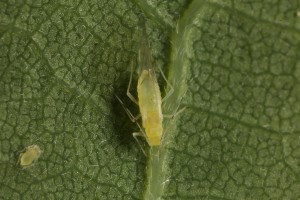
In fact, it looked as though it was quite common on this oak too, as I spotted several more on other leaves. I’ve taken to searching the underside of tree leaves in recent years, as that is often where invertebrates feed, hidden from the sight of the birds that prey on them. I quickly found some examples of one of my favourite groups of insects – the aphids. I had to rely on the help of another expert – Ed Baker, who did the first aphid survey for us on Dundreggan in 2012 – to get this one identified, and it too was a common species, restricted to oaks – Tuberculatus annulatus.
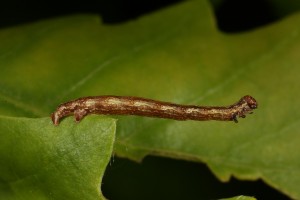
There were plenty of leaves within easy reach on this tree, so as I continued to search, I found more and more life on them. On one leaf I spotted a twig-mimicking caterpillar, and another expert, Roy Leverton, advised me it was from a geometer moth, probably an Agriopis species, and likely to be either the dotted border moth (Agriopis marginaria) or the scarce umber moth (Agriopis aurantaria). He said that for similar species like this, sometimes the only way to achieve a definitive identification is to rear the caterpillars to adulthood.
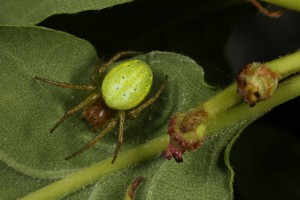
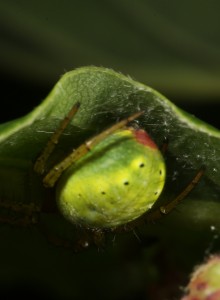
On the underside of another nearby leaf I was pleased to find an invertebrate that I could identify myself – a bright green spider. This was the cucumber spider (Arienella cucurbitina), one of our most distinctive spiders, which featured in a previous blog of mine from Glenmoriston, where wood ants (Formica lugubris) were attempting to steal its eggs. While the colour gives a clue to the identity of this spider, the confirming feature is a red patch at the end of its abdomen, and when I turned the leaf around to get a different view of this one, the patch was clearly visible.
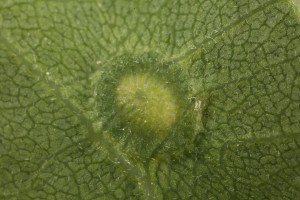
Oak trees are well-known for hosting a lot of different types of plant galls, and the week before I’d found a distinctive gall, the cotton wool gall, induced by a wasp (Andricus querusramuli) on the catkins of an oak at Dundreggan. That was the first time I’d come across that particular gall, so I was searching this oak in Glen Affric, in the hope that I’d see it there as well. However, in the event, I was unsuccessful, as there was no sign of it on this tree that day.
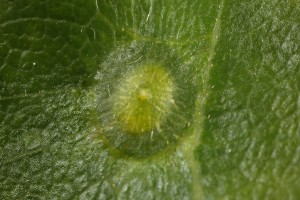
However, I did spot a gall on some of the leaves that I wasn’t familiar with. It took the form of a round, seemingly transparent blister with a raised centre to it. Checking my guide to galls, it looked like the gall that is induced by the sexual generation of a wasp (Neuroterus numismalis), and this was confirmed for me by Peter Shirley, an expert on oak galls, who had recently visited Dundreggan. The males and females that emerge from these galls mate in the summer and lay their eggs on oak leaves, where they induce the formation of the silk button spangle galls, which I’ve often photographed. However, this was the first time I’d come across the more inconspicuous galls containing the sexual generation of the wasps.
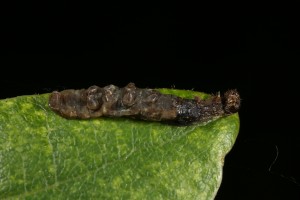
On another leaf, my attention was drawn by a dark brown shape and when I looked closely I saw that it was a dead caterpillar, lying face up on the leaf. I had no idea why this had died, but I photographed it anyway, hoping that it might still be identifiable. However, when I sent the image to Roy Leverton, he replied that it was impossible to provide an identification, as the colour would have changed after it died – all that he could offer is that it was of a Noctuid moth.
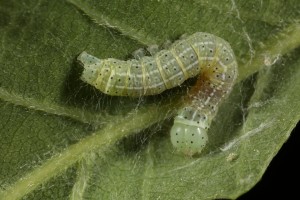
It was unusual to see a dead caterpillar like that, and I was continuing to find many more that were alive. Quite a few of these were identified for me by Roy as being of the common quaker moth (Orthosia cerasi), although some of them were not well enough developed to make an absolute certainty of the identification. This moth is a common species throughout the UK, and oak is one of the main foodplants for its caterpillars, so it wasn’t surprising to be seeing quite a few of them on this tree.
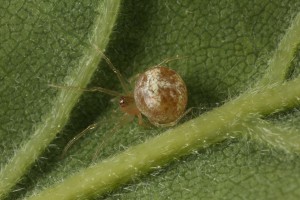
On another leaf I found a tiny spider, in between the veins on its underside. This was very obviously an immature individual, and I’ve learned enough about spiders to know that it would be impossible to identify it. The characteristic features which enable many spiders to be identified to species level don’t develop until the spiders are fully grown. This one, by contrast, looked like it had only recently hatched out from its egg.
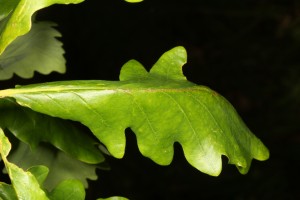
In many cases, it’s a question of searching the undersides of leaves for any sign of insects there, but sometimes the shape of the leaves themselves give away the presence of an invertebrate. One leaf that I spotted had an unusual shape, with the central vein forming a ridge and the outer edges of the leaf sloping down on each side, so that it formed almost a tent-like structure. Turning the leaf over, I saw that there was indeed a tiny caterpillar, feeding on the underside of the leaf, right along the central vein.
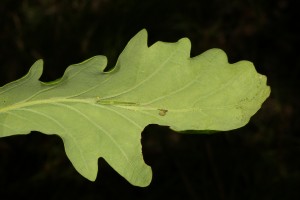
I guessed that by feeding there, it was somehow affecting the shape of leaf, causing it to droop in the way it had, so that the outer edges of the leaf offered some protection from being seen. I’d previously seen some aphids (Pachypappa tremulae) feeding on aspen trees (Populus tremula) in Glenmoriston that achieved the same effect – the aspen’s leaves hung down forming a tent-like shape that kept the aphids out of sight, and presumably safe from predators and parasites.
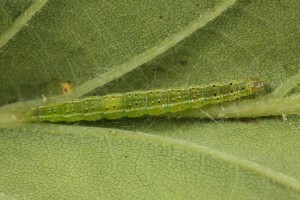
I took some closer photographs of the caterpillar, and I had to send them to a different specialist – Bob Heckford, an expert in micro-moths, who has been kindly helping me out with identifications. He responded that it was from a species called Ypsolopha parenthesella, which is common throughout Britain, and whose caterpillars feed on oak and hazel (Corylus avellena) amongst other trees.
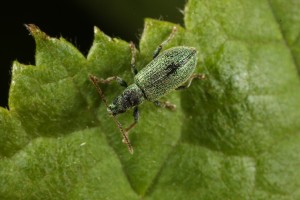
By this time I’d spent almost an hour at this one oak tree, finding plenty of interest, and taking photographs of many of the insects. Nearby, there was a young hazel, also beside the road, which we had protected with an individual tree guard many years ago, so that it could grow with being overgrazed by red deer (Cervus elaphus). It had done very well, and the guard had been removed some years back, because it had reached a sufficient size that it was safe from the deer.
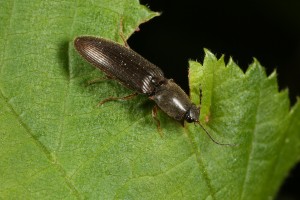
I decided to have a look at the hazel, for although it doesn’t host as many invertebrate species as oak does, it nevertheless still supports a good range of insects. Almost immediately, my eye was drawn by a bright green metallic shape on one leaf – it was the silver green leaf weevil (Phyllobius argentatus), one of most attractive and readily-identifiable beetles in our forest. On another leaf, I saw a larger, but less colourful click beetle (Athous haemorrhoidalis), which is also a common species and easy to identify.
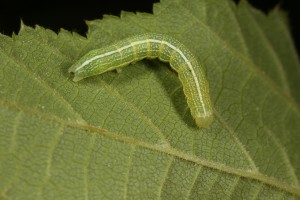
Searching on the underside of some of the leaves soon led to the discovery of another caterpillar – a slightly different one to those I’d seen on the oak. Again I had to call on Roy Leverton’s expertise, and he informed me that this one was the larva of the clouded drab moth (Orthosia incerta) – a close relative of the common quaker that was on the oak tree. Both are green in colour, with a pattern of lines on their bodies, which provides good camouflage for them against the leaves they feed on.
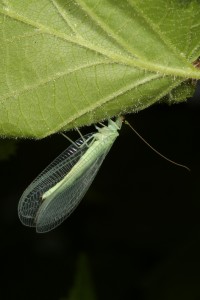
While I was looking at the caterpillar some movement nearby caught my eye, and I saw a bright, pale green shape on another leaf. It was a green lacewing – so-called because of the delicate tracery of veins on its leaves, which is reminiscent of lace work.
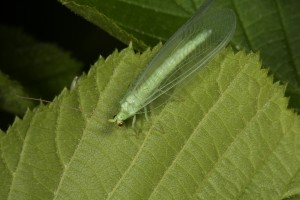
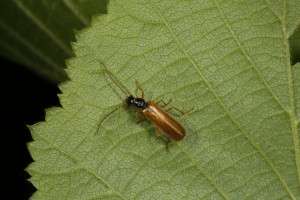
I was later able to identify this as being a species called Chrysoperla carnea – there are relatively few lacewings occurring in Scotland, which makes identification of them fairly simple. Turning over another leaf revealed another beetle – one which I recognised as being a soldier beetle, although I didn’t know which species it was. I had to call on the expertise of another specialist, Richard Lyszkowski, who has done a beetle survey for us at Dundreggan, for assistance, and he duly identified it as being Rhagonycha lignosa.
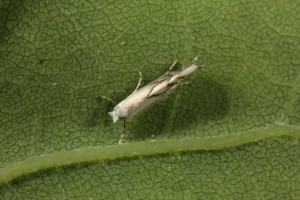
Another hour or so had gone by now, and I was thinking of moving further into the glen – remarkably I’d spent over 2 hours at these two trees no more than 5 metres from my car! I had one last look at the oak before driving off, and spotted something else on one of the leaves – it was a micro-moth. I had to contact Bob Heckford to get it identified, and he told me it was a common species called Phyllonorycter harrisella, whose larvae feed on oak, making blotch-like mines in the leaves.
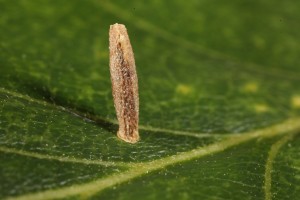
The caterpillars of other micro-moths make tubular structures called cases on the leaves of trees, and as a result those species are known as case-bearers. The larvae pupate into adults inside the cases, and the shapes of the cases can be quite distinctive, enabling the species to be identified from them. I spotted several such cases, both on the oak, and also on the hazel, and I think these may be the work of a micro-moth called Coleophora serratella, but I’m still waiting to get that ID confirmed or corrected by experts.
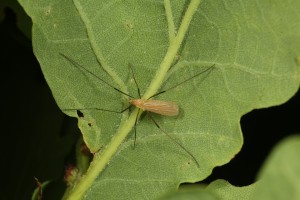
The underside of another oak leaf revealed a different insect. It was a cranefly, a distinctive group within the Order Diptera, which are also sometimes called ‘daddy long legs’, because of the length of their legs. This wasn’t a species I recognised, and when I sent the photograph to Peter Chandler, one of the country’s leading dipterists (who’s also done some survey work for us at Dundreggan) he replied that it was a species in the genus Molophilus. However, he went on to say that identification to species level is only possible by checking the male genitalia, and as I didn’t catch this individual, that wasn’t possible in this situation.
There’s still plenty more to write about from this day in Glen Affric, but as this blog is already quite long, I’ll take a break here, and continue it in Part 2, as a separate blog entry.
Hello to Alan and all the regulars who enjoy this blog,
Reading these posts is a pleasure and it arms me with more knowledge of the various creepy crawly’s that live in my garden.
Your pictures of Glen Affric are a great substitute for the real thing. I wasn’t able to volunteer this year but I defiantly feel closer to the Caledonian forest after reading your blog.
Keep up the good work.
Hi Austin,
Thanks for your comment, and I hope you can get up to Glen Affric to see the forest in real life again soon. We have more volunteer weeks scheduled there for this autumn. Please see: http://www.treesforlife.org.uk/conservationweeks.php
With best wishes,
Alan
Dear Allan thanks from a french follower for your genuine”scientific tales ” about glenn forest Affric”, a beloved place ,beautifully illustrated and focusing on unnoticed tiny insects one is inclined to overlook while rambling hurriedly under the cover ….. longing for the sequel 2….Frédérique
Hi Frédérique, Thanks for your comment. Part 2 of that blog is available here.
With best wishes,
Alan
I have slowly begun to sensitize myself to the truly incredible abundance of life all around us in our natural world and manage to discover something new each day. Thanks for your very interesting and inspirational blog about the amazing variety of insect life to be found under the leaves of oak trees. You have inspired me to look even closer in my walks through the forest.
John Lowry
Hi John,
Thanks for your inspiring comment – there is indeed a world of wonder all around us, which anyone can discover when we take the time to look closely at Nature. It’s great to get feedback like yours, as that in turn inspires me to continue sharing my experiences through my blog – many thanks!
With best wishes,
Alan
I learned a lot about the insect and spider worlds reading this blog, like not being able to identify spiders till they are more mature, and fascinating facts like the vertical case of the micro-moth. I was wondering if the dead-caterpillar happened because of air pollution due to airplanes dumping their fuels, but I might be imagining too far into this.
Thank you for your close observations, great attention to the life forms in forests, and going to the length to talk to specialists and insect experts to have the insects and spiders identified. Your work is a gift and a bridge between life in the wild and the human world.
Hi Pupak,
Many thanks for writing about how my blog has inspired you – it’s great to get feedback like this.
I very much doubt that the caterpillar died for the reason you mentioned – there is very little atmospheric pollution in Glen Affric, as evidenced by the quantity and abundance of lichens growing on the trees there.
With best wishes,
Alan
Hello Alan,
I really enjoyed this most instructive post on your web site – it tempts me to look more carefully at and under the leaves of trees and bushes as I walk about here.
With best wishes,
Paul
Hi Paul,
Many thanks for your comment – I’m delighted that my blog has inspired you to look more closely at leaves etc. As I continue to discover, there’s a whole world of wonder and interest there.
With best wishes,
Alan